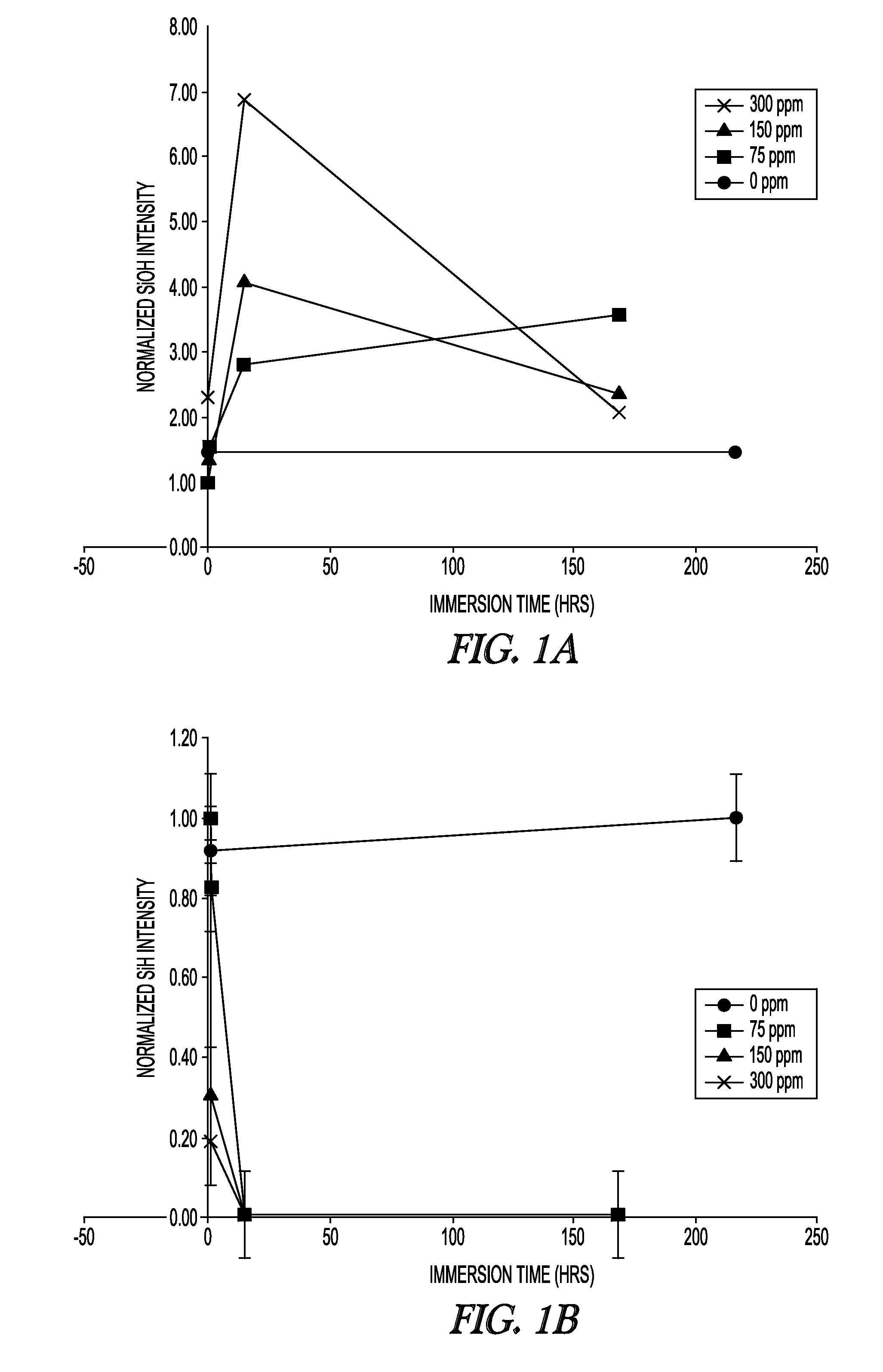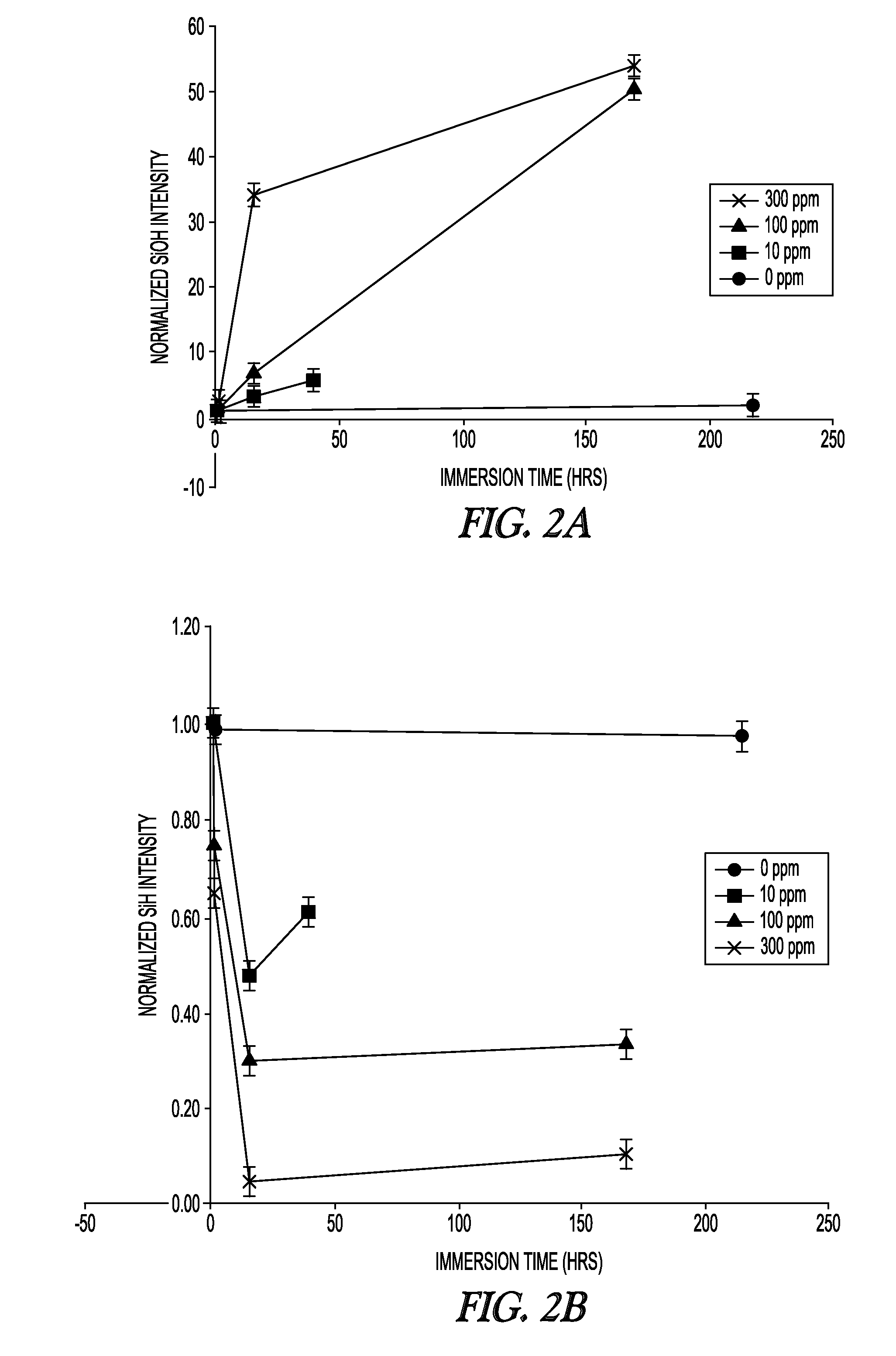Organopolysiloxane compositions and surface modification of cured silicone elastomers
a technology of organic polysiloxane and composition, which is applied in the direction of membranes, separation processes, transportation and packaging, etc., can solve the problems of limiting the material properties of silicone, low surface energy, and degradation of one or more desirable properties of silicone elastomers, so as to increase the hydrophilicity of the treated surface, and reduce the effect of surface degradation
- Summary
- Abstract
- Description
- Claims
- Application Information
AI Technical Summary
Benefits of technology
Problems solved by technology
Method used
Image
Examples
reference example 1
Attenuated Total Reflectance Infrared (ATR-IR) Spectroscopy
[0098]Samples were tested at ambient laboratory conditions using a Nicolet 6700 FTIR equipped with a Smart Miracle accessory having a zinc selenide crystal. Samples soaked in water were first blotted completely dry with a Kimwipe and in some cases blown dry with compressed air or nitrogen before being placed with the surface exposed to air during curing face-down on the crystal and brought into light contact with a clamp. Data acquisition was conducted within 5 minutes of removal from solution. The contact pressure was kept to the minimum needed to establish complete crystal contact, as judged by previewing the spectral quality. Comparison of Si—H and Si—OH peak heights (around 2160 cm−1 and broad signal around 3390 cm−1, respectively) among samples was done with identical baseline points and normalized by a suitable internal reference peak for the asymmetric CH3 deformation at 1446 cm−1. Relative concentrations over water e...
reference example 2
[0099]Uncured samples were transferred from a sealed container to the gap between two 8 mm diameter parallel plates pre-heated at 70° C. in a TA Instruments ARES 4400 strain controlled rheometer and compressed to a final gap of 1.5 mm at room temperature. Excess sample was trimmed with a razor blade, then heated promptly in the environmental chamber to a temperature of 120° C. with the autotension feature activated to maintain a constant normal force during heating. The samples were allowed to complete in-situ curing for 1 hour at 120° C. then cooled back to 25° C. under autotension. A frequency sweep was then conducted at 25° C. on the cured sample at a strain of 5% to determine its plateau dynamic storage modulus.
example 1
[0100]In a polypropylene mixing cup was combined 10.60 g of a Part A (prepared by mixing about 67.9 parts dimethylvinylsiloxy-terminated polydimethylsiloxane having a viscosity of about 2 Pa·s at 25° C., about 32 parts of organopolysiloxane resin consisting essentially of CH2═CH(CH3)2SiO1 / 2 units, (CH3)3SiO1 / 2 units, and SiO4 / 2 units, wherein the mole ratio of CH2═CH(CH3)2SiO1 / 2 units and (CH3)3SiO1 / 2 units combined to SiO4 / 2 units is about 0.7, and the resin has weight-average molecular weight of about 22,000, a polydispersity of about 5, and contains about 1.8% by weight (about 5.5 mole %) of vinyl groups, and about 0.1 parts of Karstedt's catalyst) and 1.06 g of a Part B prepared by mixing 26 parts of a dimethylvinylsiloxy-terminated polydimethylsiloxane having a viscosity of about 2 Pa·s at 25° C., 12 parts of organopolysiloxane resin consisting essentially of CH2═CH(CH3)2SiO1 / 2 units, (CH3)3SiO1 / 2 units, and SiO4 / 2 units, wherein the mole ratio of CH2═CH(CH3)2SiO1 / 2 units and (...
PUM
| Property | Measurement | Unit |
|---|---|---|
| mole ratio | aaaaa | aaaaa |
| time | aaaaa | aaaaa |
| permeable | aaaaa | aaaaa |
Abstract
Description
Claims
Application Information
 Login to View More
Login to View More - R&D
- Intellectual Property
- Life Sciences
- Materials
- Tech Scout
- Unparalleled Data Quality
- Higher Quality Content
- 60% Fewer Hallucinations
Browse by: Latest US Patents, China's latest patents, Technical Efficacy Thesaurus, Application Domain, Technology Topic, Popular Technical Reports.
© 2025 PatSnap. All rights reserved.Legal|Privacy policy|Modern Slavery Act Transparency Statement|Sitemap|About US| Contact US: help@patsnap.com



